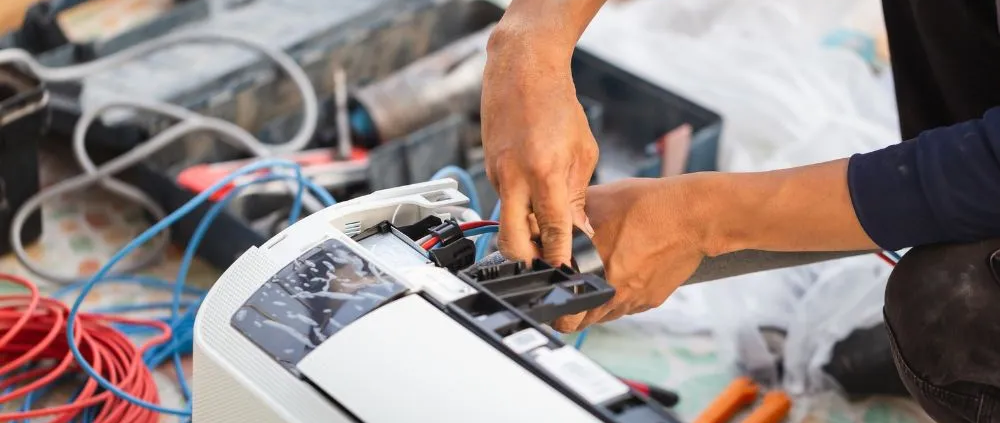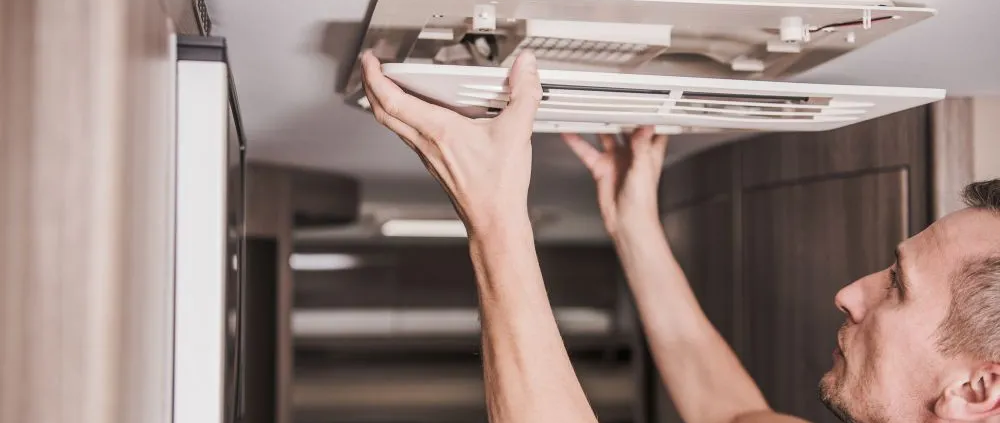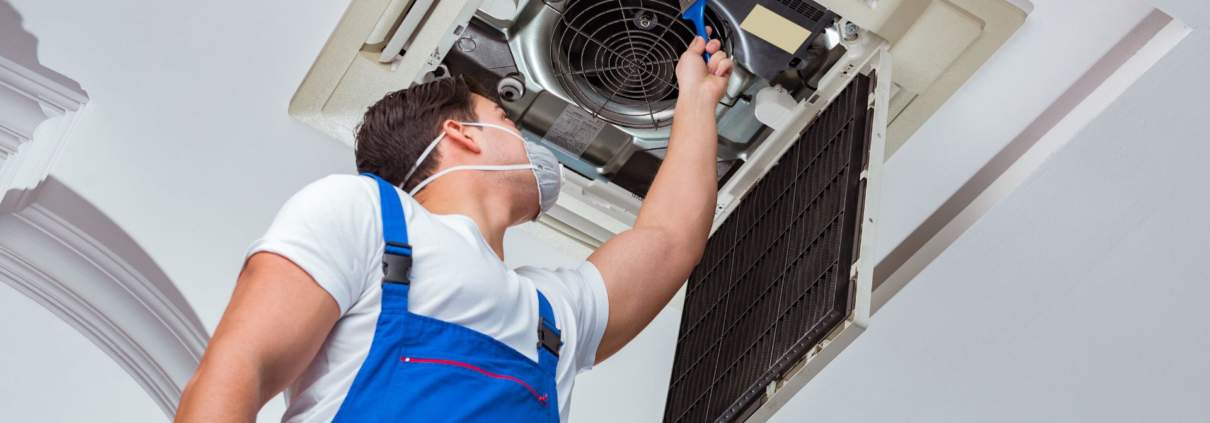How to repair RV air conditioner shroud
Repairing an RV air conditioner shroud can be a relatively simple task, and it’s essential to address any damage promptly to maintain the unit’s efficiency and protect it from the elements. Here’s a step-by-step guide on how to repair an RV air conditioner shroud:
Materials Needed:
- Fiberglass repair kit or ABS plastic welding kit (depending on the shroud material)
- Sandpaper
- Cleaning solution (e.g., isopropyl alcohol)
- Cloth or sponge
- Masking tape
- UV-resistant spray paint (matching the shroud color)
Steps:
Assessment:
- Inspect the RV air conditioner shroud for cracks, holes, or other damage.
- Identify the shroud material (commonly fiberglass or ABS plastic).
Clean the Shroud:
- Wipe the damaged area with a cleaning solution, such as isopropyl alcohol, to remove dirt, grime, and any residue.
Prepare the Surface:
- Use sandpaper to roughen the damaged area slightly. This helps the repair material adhere better.
Repair with Fiberglass Kit (for Fiberglass Shrouds):
- If the shroud is made of fiberglass, follow the instructions on the fiberglass repair kit.
- Apply the fiberglass repair resin or epoxy to the damaged area.
- Place the fiberglass mesh or fabric over the resin, ensuring full coverage.
- Apply another layer of resin over the mesh and smooth it out.
- Allow the repair to cure according to the kit instructions.
Repair with ABS Plastic Welding Kit (for ABS Plastic Shrouds):
- If the shroud is made of ABS plastic, use an ABS plastic welding kit.
- Clean the damaged area thoroughly.
- Follow the kit instructions to weld the plastic together, filling any cracks or holes.
Sand and Smooth:
- Once the repair has fully cured or dried, use sandpaper to smooth out any rough edges or uneven surfaces.
Masking and Painting:
- Mask off the repaired area with masking tape to protect the surrounding shroud.
- Use UV-resistant spray paint in a color that matches the shroud to paint over the repaired area.
- Follow the paint manufacturer’s instructions regarding drying and curing times.
Final Inspection:
- Once the paint has dried and cured, inspect the repaired area to ensure it blends seamlessly with the rest of the shroud.
By following these steps, you can effectively repair your RV air conditioner shroud, providing it remains sturdy and visually appealing. Regular maintenance and prompt repairs contribute to the longevity of your RV’s air conditioning system.
You may like also:
Keeping Cool on the Road: A Comprehensive Guide to RV Air Conditioner Repair
Embarking on a road trip in your RV is an exciting adventure, but when the heat starts to rise, a malfunctioning air conditioner can quickly make your journey uncomfortable. In this comprehensive guide, we’ll discuss common issues with RV air conditioners and provide practical tips for troubleshooting and repair.
Understanding Your RV Air Conditioner:
- Before delving into repairs, it’s essential to have a basic understanding of how your RV air conditioner operates. Most RV air conditioners work similarly to those found in homes, utilizing a compressor, condenser, evaporator, and fan to cool the air. Familiarizing yourself with these components can make troubleshooting more straightforward.
Common Issues and Solutions:
No Power or Electrical Problems:
- Check the power source and ensure proper connections.
- Inspect fuses and breakers in the RV electrical panel.
- Verify the thermostat settings.
Poor Cooling Performance:
- Clean or replace air filters for improved airflow.
- Remove obstructions from air intake and exhaust vents.
- Clean evaporator and condenser coils to enhance heat exchange.
Strange Noises:
- Inspect fan blades for obstructions.
- Tighten loose bolts or screws.
- Lubricate the motor and fan bearings if necessary.
Refrigerant Issues:
- Consult a professional for suspected refrigerant leaks.
- Check for ice buildup on evaporator coils.
Thermostat Problems:
- Verify proper thermostat functioning and temperature settings.
- Replace thermostat batteries if applicable.
Water Leaks:
- The clear condensate drain of any clogs.
- Ensure the RV is level for proper drainage.
Preventive Maintenance Tips:
Regular maintenance is key to avoiding major issues. Consider the following:
- Clean or replace air filters every few months.
- Inspect and clean coils at the beginning of each season.
- Keep the area around the air conditioner unit free from debris.
When to Seek Professional Help:
While many RV air conditioner issues can be resolved with DIY efforts, some may require professional assistance. If you’re uncertain about the problem or lack the necessary expertise, consult a qualified RV air conditioner technician.
Conclusion:
Maintaining a functional RV air conditioner is crucial for a comfortable and enjoyable road trip experience. By understanding the common issues and implementing preventive maintenance measures, you can keep your RV cool and your adventures stress-free. Remember, when in doubt, seek professional help to ensure the longevity of your RV air conditioning system. Safe travels!
How to repair air conditioner compressor
Is there anything more frustrating than a malfunctioning air conditioner on a scorching summer day? The culprit often lies within the heart of the system – the compressor. When this vital component fails, it can leave you sweating and scrambling for a solution. But fear not! With the right guidance and know-how, repairing your air conditioner compressor doesn’t have to be an impossible challenge. In this article, we’ll explore the essential steps and techniques for tackling this daunting task head-on, empowering you to take control of your cooling woes and restore comfort to your home.
Symptoms of a faulty compressor
When your air conditioner starts blowing warm air or making strange noises, it could be a sign of a faulty compressor. One common symptom is reduced cooling efficiency, as the compressor struggles to circulate refrigerant and maintain proper pressure levels. This can lead to higher energy consumption and increased system wear and tear, ultimately resulting in more frequent breakdowns.
Another telltale sign of a failing compressor is rapid cycling on and off, known as short cycling. This not only compromises indoor comfort but also puts unnecessary stress on other components, potentially causing further damage to the entire HVAC system. Ignoring these symptoms can lead to costly repairs or even premature replacement of the entire air conditioning unit.
To address compressor issues effectively, consult with an experienced HVAC technician who can diagnose the problem accurately and recommend appropriate solutions. Whether repairing minor faults or replacing the compressor altogether, timely intervention can prevent larger issues from developing and ensure optimal cooling system performance.
By identifying these warning signs early on, homeowners can take proactive measures to avoid potential air conditioning woes down the line. Regular maintenance and prompt attention to any unusual behavior exhibited by the compressor are key to preserving indoor comfort and prolonging the lifespan of your air conditioning system.
Tools and equipment needed for repair
Having the right tools and equipment is essential for a successful outcome. Some of the most crucial items include a multimeter for testing electrical components, a refrigerant recovery unit for safely removing refrigerant, and a vacuum pump for evacuating the system before recharging. Additionally, a set of wrenches, screwdrivers, and pliers are indispensable for disassembling and reassembling various components.
One often overlooked aspect of compressor repair is proper diagnosis using specialized tools such as pressure gauges and thermometers. These tools help identify the root cause of the compressor issue, whether it’s related to low refrigerant levels or a faulty component. Moreover, investing in high-quality replacement parts that meet manufacturer specifications can avoid recurring problems down the line. Utilizing these tools effectively not only saves time but also ensures that the repair work is done accurately.
Furthermore, technicians must stay informed about new developments in air conditioning technology and repair methods. With advancements in compressor design and diagnostic tools constantly evolving, keeping abreast of industry updates can lead to more efficient repairs and customer satisfaction. By regularly expanding one’s knowledge base through training programs or industry publications, technicians can remain at the forefront of delivering top-notch compressor repairs.
Understanding your HVAC system isn’t just essential during regular inspections; knowing how to fix it when things go wrong could save you tons on maintenance costs! Whether there’s been storm damage or if your unit hasn’t worked properly since installation, diagnosing issues quickly will ensure minimal disruption to your daily life while saving you money long-term on utility bills, too! Remember, folks: Knowledge truly is power when it comes down to ac compressors!
Steps to troubleshoot and diagnose the issue
The first step is always to troubleshoot and diagnose the issue accurately. One of the common problems that can occur with compressors is electrical malfunctions, which may require a thorough inspection of wiring and connections. Additionally, checking for leaks in the refrigerant lines and ensuring there are no obstructions in the airflow should be part of your troubleshooting process.
A great way to approach compressor repair is by conducting a system pressure test to identify any potential issues with the refrigerant levels. This initial step can provide valuable insights into whether low or high pressure could be causing compressor problems. In addition, checking for any abnormal noises or vibrations during operation can help pinpoint mechanical issues within the compressor. By diligently following these steps to troubleshoot and diagnose air conditioner compressor issues, you can minimize downtime and ensure efficient repairs that improve overall system performance.
Repairing or replacing the compressor
When it comes to repairing an air conditioner compressor, sometimes the decision is only sometimes clear-cut. While some issues can be easily remedied with a simple fix, deeper compressor problems may warrant a replacement. It’s crucial to consider factors such as the age of the unit, the cost of repairs versus replacement, and the overall efficiency of the system. For older units, replacing a faulty compressor might make more sense in terms of long-term savings and improved performance.
Furthermore, understanding the underlying cause of compressor failure is key to making an informed decision. Factors such as inadequate maintenance, refrigerant leaks, or electrical issues can contribute to compressor malfunctions. By addressing these root causes during a repair or replacement process, homeowners can ensure that their air conditioning system operates at optimal efficiency and longevity.
Ultimately, whether one chooses to repair or replace an air conditioner compressor depends on various considerations – cost-effectiveness, energy efficiency improvements – but seeking professional advice to assess the best course of action is always advisable for ensuring long-term satisfaction and comfort in your home.
Testing the repaired compressor
Once the air conditioner compressor has been repaired, it is crucial to thoroughly test its functionality before re-installing it. Testing the repaired compressor can help ensure that the problem has been adequately addressed and that the unit is safe to operate. This step involves checking the pressure levels, monitoring for any unusual noises or vibrations, and verifying that the compressor is effectively cooling the air.
Another essential aspect of testing a repaired compressor is to assess its energy efficiency. A well-repaired compressor should not only function properly but also operate with minimal energy consumption. By conducting thorough efficiency tests, homeowners can be confident in their air conditioner’s performance and avoid costly utility bills.
Conclusion:
Repairing an air conditioner compressor requires careful consideration and expertise to ensure that the unit functions efficiently and effectively. By understanding the common issues that can arise with compressors, homeowners can take proactive steps to address any problems and prolong the lifespan of their cooling system. Whether it’s a simple fix or a more complex repair, seeking professional help is crucial to avoid further damage or safety hazards. Regular maintenance and timely repairs can not only save money in the long run but also contribute to a healthier indoor environment. Therefore, it is essential for homeowners to schedule regular maintenance checks and promptly address any compressor issues to keep their air conditioning systems running smoothly.
In summary, just as homeowners optimize their air conditioning systems through careful consideration and timely repairs, ice casino enthusiasts can enhance their gaming experiences through proactive measures. Identifying challenges, exploring diverse games, and maximizing bonuses contribute to a more enjoyable and rewarding online gaming journey.





